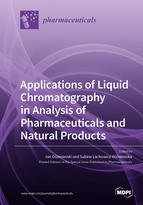Applications of Liquid Chromatography in Analysis of Pharmaceuticals and Natural Products
A special issue of Pharmaceuticals (ISSN 1424-8247). This special issue belongs to the section "Natural Products".
Deadline for manuscript submissions: closed (20 September 2021) | Viewed by 55735
Special Issue Editors
Interests: phenolic compounds; isolation and qualitative and quantitative determination of polyphenols; bioactive compounds; UV-VIS HPLC-MS-MS and SPE
Special Issues, Collections and Topics in MDPI journals
Interests: nutraceuticals and functional foods; medicinal plants; bioactive compounds; HPLC; LC-MS; nutrition; antioxidant agent; prebiotics; probiotics; symbiotics; bioavailability in vitro
Special Issues, Collections and Topics in MDPI journals
Special Issue Information
Dear Colleagues,
It is our pleasure to present this Special Issue of Pharmaceuticals, entitled “Applications of Liquid Chromatography in Analysis of Pharmaceuticals and Natural Products”. Plants produce a wide range of phytochemicals, which are secondary metabolites that confirm their identity and are used for the production of natural pharmaceuticals, among other things. The use of modern chromatographic techniques allows accurate quantitative and qualitative identification of the above-mentioned phytochemicals and their natural products. Liquid chromatography is one of the most efficient and robust specific techniques, due to the merits of convenience and strong separation ability, as well as a wide range of material applications for identification. Liquid chromatography is widely used for the analysis of plants, nutraceuticals, pharmaceuticals, natural product quality control, or quantitative determination of bioactive compounds. The most commonly used for the identification of different plant material and pharmaceuticals are the ultra- and high-performance liquid chromatography with UV-VIS, fluorescence, diode array, and equipped with mass spectrometry or tandem mass spectrometry detection methods. Therefore, for this Special Issue will publish work concerning the latest scientific news, insights, and advances in the field of innovation and applications of liquid chromatography in the analysis of phytochemicals and natural products. Original research articles, short communications, and critical review articles are welcome. The information presented will certainly arouse considerable interest among a large group of our readers from different disciplines and research fields.
Prof. Jan Oszmianski
Dr. Sabina Lachowicz
Guest Editors
Manuscript Submission Information
Manuscripts should be submitted online at www.mdpi.com by registering and logging in to this website. Once you are registered, click here to go to the submission form. Manuscripts can be submitted until the deadline. All submissions that pass pre-check are peer-reviewed. Accepted papers will be published continuously in the journal (as soon as accepted) and will be listed together on the special issue website. Research articles, review articles as well as short communications are invited. For planned papers, a title and short abstract (about 100 words) can be sent to the Editorial Office for announcement on this website.
Submitted manuscripts should not have been published previously, nor be under consideration for publication elsewhere (except conference proceedings papers). All manuscripts are thoroughly refereed through a single-blind peer-review process. A guide for authors and other relevant information for submission of manuscripts is available on the Instructions for Authors page. Pharmaceuticals is an international peer-reviewed open access monthly journal published by MDPI.
Please visit the Instructions for Authors page before submitting a manuscript. The Article Processing Charge (APC) for publication in this open access journal is 2900 CHF (Swiss Francs). Submitted papers should be well formatted and use good English. Authors may use MDPI's English editing service prior to publication or during author revisions.
Keywords
- Plant materials
- Pharmaceuticals
- Nutraceuticals
- Product quality
- Innovative methods
- Food safety
- Phytochemicals
- Polyphenolic compounds
- Isoprenoids
- Bioactive compounds
- Food chemistry
- Natural products
- Mass spectrometry
- Extraction
- LC-MS/MS techniques
- HPLC-DAD-MS
Related Special Issues
- Anticancer Compounds in Medicinal Plants in Pharmaceuticals (21 articles)
- Medicinal Plants and Natural Compounds for Modulation of Neuroendocrine-Immune System and Potential Use in Ageing-Related Disorders in Pharmaceuticals (4 articles)
- Nutraceuticals and Botanicals: Bioactive Molecules and Therapeutic Properties for Human Health in Pharmaceuticals (5 articles)
- Plant Phytochemicals on Drug Development in Pharmaceuticals (6 articles)
- Medicinal Plants 2020 in Pharmaceuticals (26 articles)
- Bioactive Compounds from Plants and Foods with Pharmaceutical Interest in Pharmaceuticals (28 articles)








